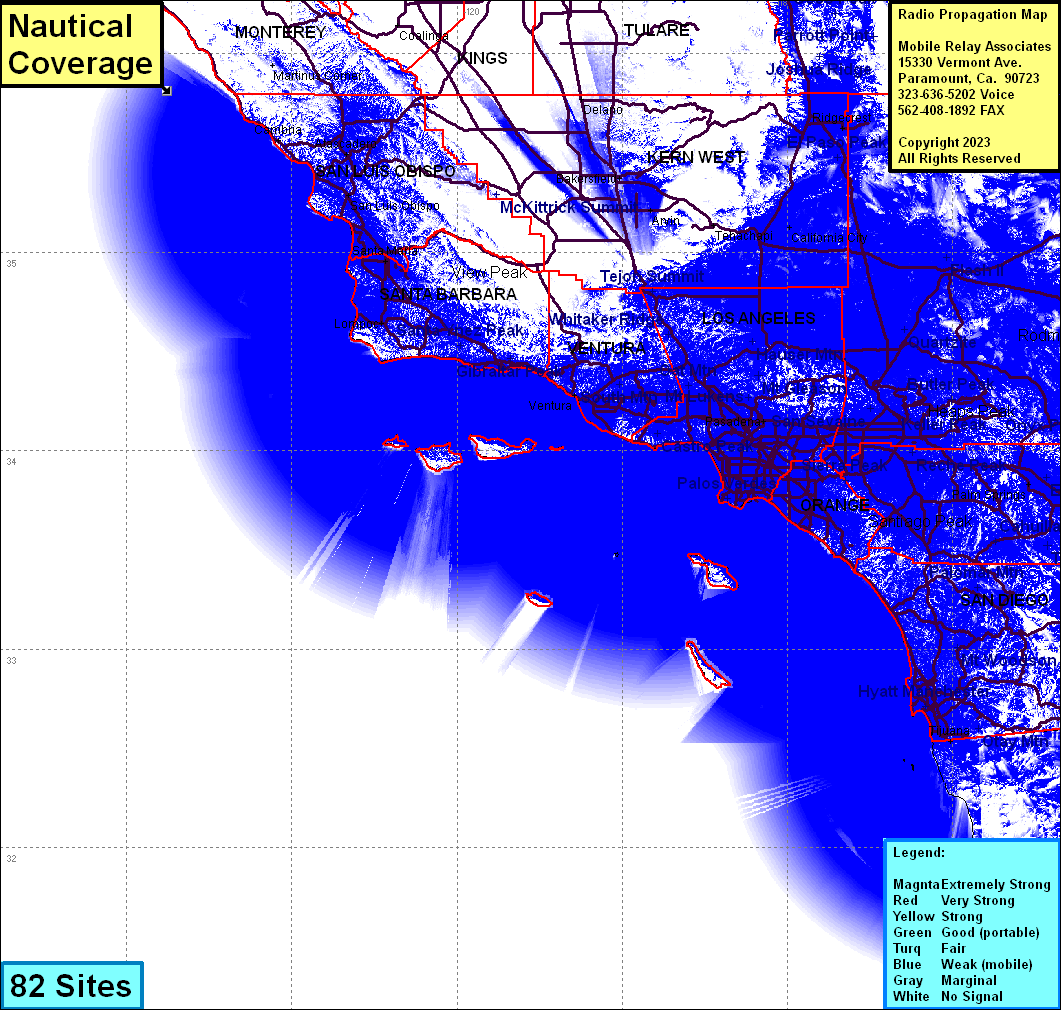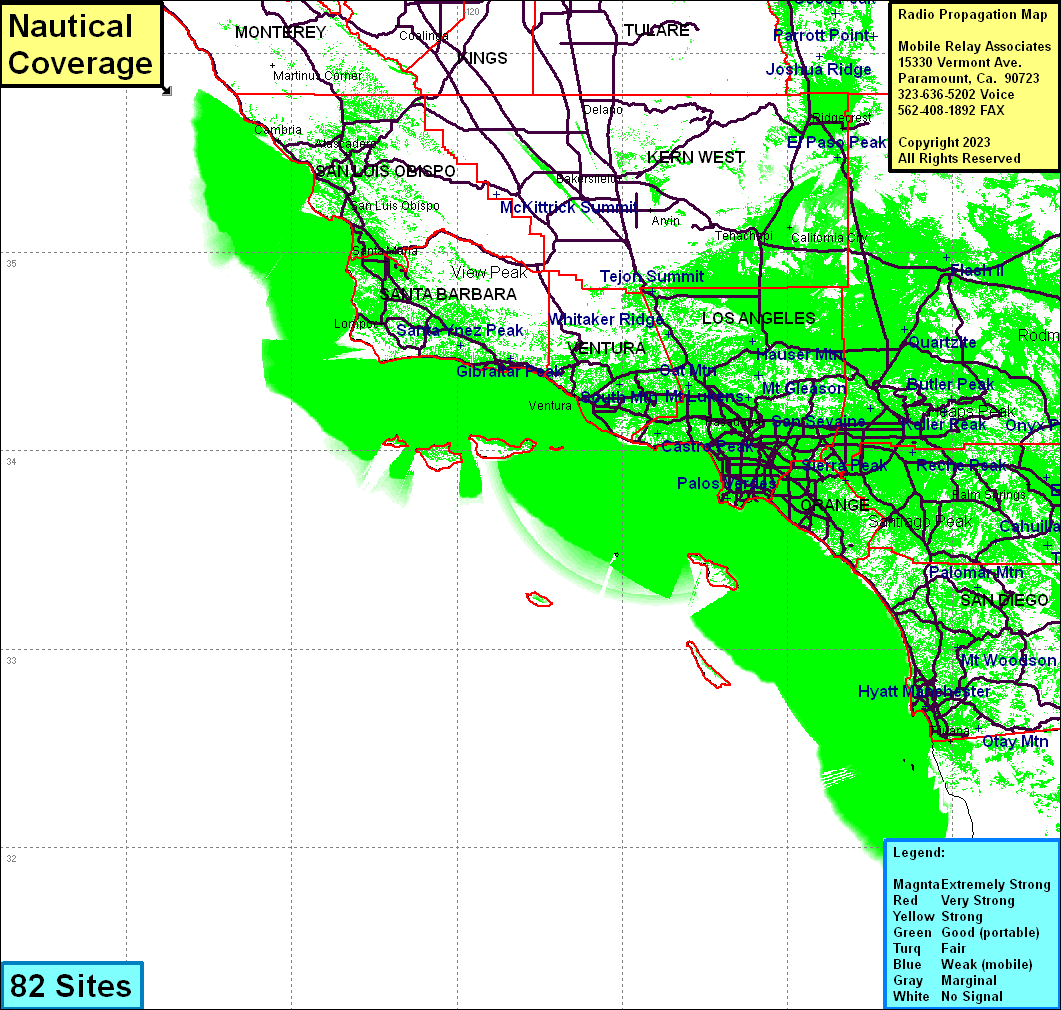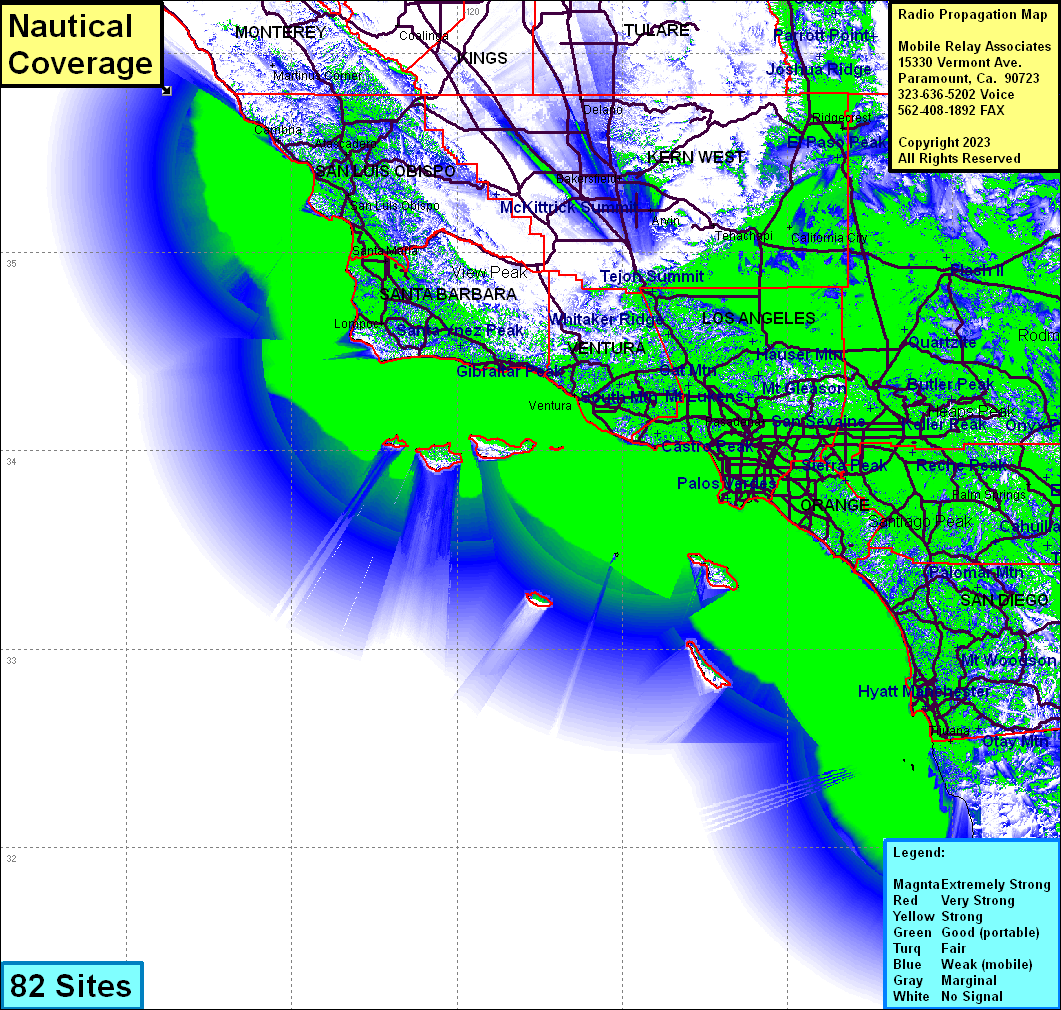

Marine radios, which are typically installed on boats, operate on the Very High Frequency (VHF) Marine band. These radios play an indispensable role in maritime safety, greatly contributing to emergency rescue operations and general navigation on the water. They allow for essential communication between vessels and with shore stations, providing up-to-date weather reports, distress signal broadcasts, and a means for vessels to keep in touch with one another. However, while these radios are a critical component of boating safety, they are not without their associated shortcomings. Their performance is greatly influenced by a range of factors; the most critical of these is line of sight. Essentially, for a radio signal to be received, the transmitting and receiving antennas must be within sight of each other. This is often a limiting factor for these radios. Despite the vast expanses of open waters devoid of typical obstructions such as buildings or mountain ranges, another natural obstacle comes into play. This obstacle is the curvature of the earth itself. The earth’s curvature and the closer-than-perceived horizon significantly limit the range of the marine radio. Radio waves will go about 10% beyond the visual horizon. For most power boats, the marine radio has an effective operational range of about 14 miles from boat to boat. This is insufficient to even reach from Los Angeles to Catalina Island. This is because the radio waves travel in a straight path, and beyond certain distances, they simply move past the receiver due to the Earth’s curved surface. Hence, the 14-mile range is essentially a function of the height of the boat’s antenna above the waterline. However, sailboats often have the advantage in this scenario. They usually mount their antennas at the top of their high masts, elevating them above the typical antenna height on power boats. As a result, sailboats can extend the range of their radios to approximately 28 miles from sailboat to sailboat, effectively doubling the communication range of their power boat counterparts. To overcome the limitations of marine VHF radios, services like the Coast Guard, Marine Exchange, and Vessel Assist often utilize strategic locations for their base stations. These organizations typically set up their radio equipment at higher altitudes on land. By doing so, they achieve a significantly greater line of sight, enabling them to extend their communication range considerably further than the typical marine radio. This expanded reach is invaluable in ensuring the safety and efficiency of maritime operations.
Over the years, we have been developing radio systems to overcome the line-of-sight limitations intrinsic to terrestrial mobile and portable radios, commonly imposed by obstructions such as mountains, buildings, and the earth’s curvature. To circumvent these hindrances, we have forged a web of interconnected mountaintop sites. During the creation of this terrestrial network, we extended significant coverage into the Pacific Ocean. A multitude of these mountaintop sites now provide coverage roughly 70 miles seaward and stretch approximately 300 miles from north of Morro Bay to the south of the Mexican border. (We do not recommend using our network south of the Mexican border as we are not licensed to operate in Mexican waters.)
In addition to these advantages, our networked radios provide:
1. The capability to communicate on land, unlike marine radios which are restricted to specific marine entities.
2. Extended communication range into the ocean, beyond the scope of cell phone coverage.
3. Access to private channels, offering a clear line without the need to filter through unrelated stations or handle interference.
4. Conversation encryption to ensure privacy and prevent unauthorized monitoring.
5. GPS tracking for both marine and land based stations.
6. A tailored emergency alert function.
7. The capacity to manage commercial or personal communications without monopolizing a marine frequency.
MRA Channel List (Proposed)
| 1 | Calling Channel | General calls to other vessels |
| 2 | Vessel Assist | |
| 3 | Coast Guard | Non-emergency calls |
| 4 | Yacht club 1 | Communication directly with clubs |
| 5 | Yacht club 2 | |
| 6 | Yacht club 3 | |
| 7 | Yacht club 4 | |
| 8 | Yacht club 5 | |
| 9 | Yacht club 6 | |
| 10 | Yacht club 7 | |
| 11 | Yacht club 8 | |
| 12 | Yacht club 9 | |
| 13 | Yacht club 10 | |
| 14 | Commercial 1 | General purpose commercial traffic |
| 15 | Commercial 2 | |
| 16 | Commercial 3 | |
| 17 | Commercial 4 | |
| 18 | Commercial 5 | |
| 19 | Commercial 6 | |
| 20 | Commercial 7 | |
| 21 | Commercial 8 | |
| 22 | Commercial 9 | |
| 23 | Commercial 10 | |
| 24 | Talk group 1 | General conversations |
| 25 | Talk group 2 | |
| 26 | Talk group 3 | |
| 27 | Talk group 4 | |
| 28 | Talk group 5 | |
| 29 | Talk group 6 | |
| 30 | Talk group 7 | |
| 31 | Talk group 8 | |
| 32 | Talk group 9 | |
| 33 | Talk group 10 | |
| 34 | Marina 1 | Communications with Marinas |
| 35 | Marina 2 | |
| 36 | Marina 3 | |
| 37 | Marina 4 | |
| 38 | Marina 5 | |
| 39 | Marina 6 | |
| 40 | Marina 7 | |
| 41 | Marina 8 | |
| 42 | Marina 9 | |
| 43 | Marina 10 | |
| 44 | Private 1 | Private channels can be configured for exclusive use of a group. Encryption is also available. |
| 45 | Private 2 | |
| 46 | Private 3 | |
| 47 | Event 1 | Channel for a particular event. |
| 48 | Event 2 | |
| 49 | Event 3 | |
| 50 | Event 4 |
Signal Level Map
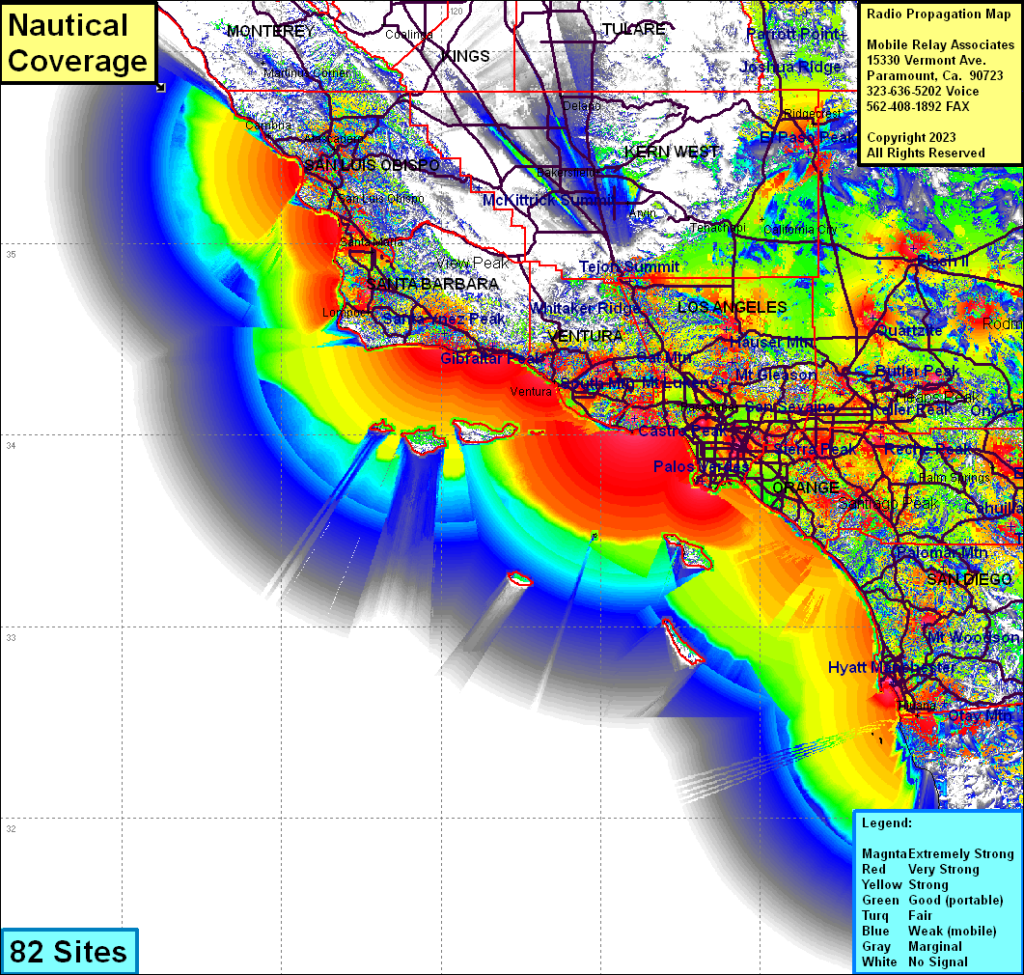
Mobile and Portable Coverage Map
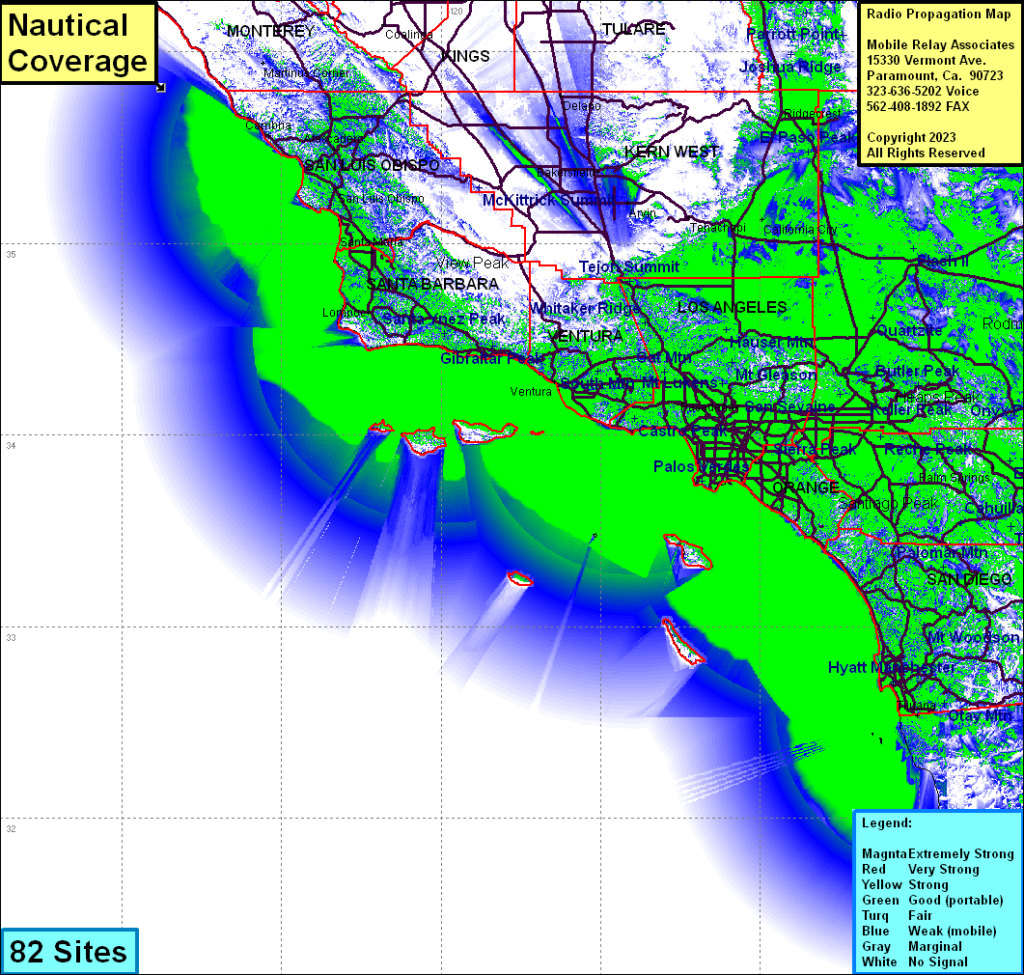
Google Earth Maps
The maps below can be viewed in Google Earth. These maps contain greater detail than those above.
| VHF Marine Frequencies | ||||
| New Channel Number | Old Channel Number | Ship Transmit MHz | Ship Receive MHz | Use |
| 1001 | 01A | 156.050 | 156.050 | Port Operations and Commercial, VTS. Available only in New Orleans / Lower Mississippi area. |
| 1005 | 05A | 156.250 | 156.250 | Port Operations or VTS in the Houston, New Orleans and Seattle areas. |
| 06 | 06 | 156.300 | 156.300 | Inter ship Safety |
| 1007 | 07A | 156.350 | 156.350 | Commercial. VDSMS |
| 08 | 08 | 156.400 | 156.400 | Commercial (Intership only). VDSMS |
| 09 | 09 | 156.450 | 156.450 | Boater Calling. Commercial and Non-Commercial. VDSMS |
| 10 | 10 | 156.500 | 156.500 | Commercial. VDSMS |
| 11 | 11 | 156.550 | 156.550 | Commercial. VTS in selected areas. VDSMS |
| 12 | 12 | 156.600 | 156.600 | Port Operations. VTS in selected areas. |
| 13 | 13 | 156.650 | 156.650 | Intership Navigation Safety (Bridge-to-bridge). Ships >20m length maintain a listening watch on this channel in US waters. |
| 14 | 14 | 156.700 | 156.700 | Port Operations. VTS in selected areas. |
| 15 | 15 | — | 156.750 | Environmental (Receive only). Used by Class C EPIRBs. |
| 16 | 16 | 156.800 | 156.800 | International Distress, Safety and Calling. Ships required to carry radio, USCG, and most coast stations maintain a listening watch on this channel. |
| 17 | 17 | 156.850 | 156.850 | State & local govt maritime control |
| 1018 | 18A | 156.900 | 156.900 | Commercial. VDSMS |
| 1019 | 19A | 156.950 | 156.950 | Commercial. VDSMS |
| 20 | 20 | 157.000 | 161.600 | Port Operations (duplex) |
| 1020 | 20A | 157.000 | 157.000 | Port Operations |
| 1021 | 21A | 157.050 | 157.050 | U.S. Coast Guard only |
| 1022 | 22A | 157.100 | 157.100 | Coast Guard Liaison and Maritime Safety Information Broadcasts. Broadcasts announced on channel 16. |
| 1023 | 23A | 157.150 | 157.150 | U.S. Coast Guard only |
| 24 | 24 | 157.200 | 161.800 | Public Correspondence (Marine Operator). VDSMS |
| 25 | 25 | 157.250 | 161.850 | Public Correspondence (Marine Operator). VDSMS |
| 26 | 26 | 157.300 | 161.900 | Public Correspondence (Marine Operator). VDSMS |
| 27 | 27 | 157.350 | 161.950 | Public Correspondence (Marine Operator). VDSMS |
| 28 | 28 | 157.400 | 162.000 | Public Correspondence (Marine Operator). VDSMS |
| 1063 | 63A | 156.175 | 156.175 | Port Operations and Commercial, VTS. Available only in New Orleans / Lower Mississippi area. |
| 1065 | 65A | 156.275 | 156.275 | Port Operations |
| 1066 | 66A | 156.325 | 156.325 | Port Operations |
| 67 | 67 | 156.375 | 156.375 | Commercial. Used for Bridge-to-bridge communications in lower Mississippi River. Inter ship only. |
| 68 | 68 | 156.425 | 156.425 | Non-Commercial. VDSMS |
| 69 | 69 | 156.475 | 156.475 | Non-Commercial. VDSMS |
| 70 | 70 | 156.525 | 156.525 | Digital Selective Calling (voice communications not allowed) |
| 71 | 71 | 156.575 | 156.575 | Non-Commercial. VDSMS |
| 72 | 72 | 156.625 | 156.625 | Non-Commercial (Inter ship only). VDSMS |
| 73 | 73 | 156.675 | 156.675 | Port Operations |
| 74 | 74 | 156.725 | 156.725 | Port Operations |
| 77 | 77 | 156.875 | 156.875 | Port Operations (Inter ship only) |
| 1078 | 78A | 156.925 | 156.925 | Non-Commercial. VDSMS |
| 1079 | 79A | 156.975 | 156.975 | Commercial. Non-Commercial in Great Lakes only. VDSMS |
| 1080 | 80A | 157.025 | 157.025 | Commercial. Non-Commercial in Great Lakes only. VDSMS |
| 1081 | 81A | 157.075 | 157.075 | U.S. Government only – Environmental protection operations. |
| 1082 | 82A | 157.125 | 157.125 | U.S. Government only |
| 1083 | 83A | 157.175 | 157.175 | U.S. Coast Guard only |
| 84 | 84 | 157.225 | 161.825 | Public Correspondence (Marine Operator). VDSMS |
| 85 | 85 | 157.275 | 161.875 | Public Correspondence (Marine Operator). VDSMS |
| 86 | 86 | 157.325 | 161.925 | Public Correspondence (Marine Operator). VDSMS |
| 87 | 87 | 157.375 | 157.375 | Public Correspondence (Marine Operator). VDSMS |
| 88 | 88 | 157.425 | 157.425 | Commercial, Intership only. VDSMS |
| AIS 1 | AIS 1 | 161.975 | 161.975 | Automatic Identification System (AIS) |
| AIS 2 | AIS 2 | 162.025 | 162.025 | Automatic Identification System (AIS) |

